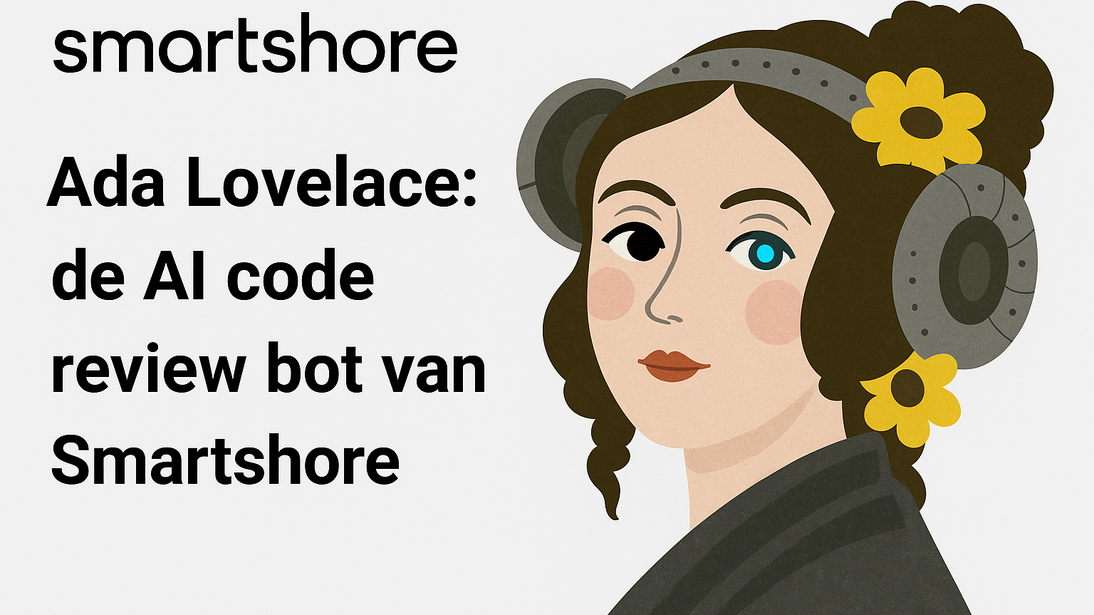News
Ada Lovelace, de AI code review bot van Smartshore
October 7, 2025
News
October 7, 2025

Just like most companies and competitors, Smartshore is also working on AI. How can we use AI for our clients, for new services and products? But we are also looking at how we can use AI internally.
Recently, we started using our own AI tool, a code review bot, called Ada Lovelace.
Ada Lovelace was the first programmer. Already in the 19th century, she saw that machines could do more than just calculations, laying the foundation for modern programming.
Two of my colleagues who are actively involved in the practical implementation of AI within Smartshore and Ability are Marcel Leicher (Smartshore) and Julia van Montfort (Ability). Together they have created Ada Lovelace created.
I asked them a few questions about Ada Lovelace:
What was the reason for developing this tool?
AI can already write code well, but we still write a lot of code ourselves. The question arose during the weekly drinks: can AI help us deliver better code and develop faster?
What problem does the tool solve for developers or organizations?
For our clients, Ada helps deliver software faster and increase quality. Our AI review bot Ada does not replace peer review, but is a valuable addition. The biggest advantage is speed: where a developer has to wait for a colleague to have time for a review, Ada provides feedback within minutes.
How does this differ from existing code quality tools (such as SonarQube, ESLint, etc.)?
Ada looks directly at the changes made and their quality, providing immediate feedback in the pull request. The biggest difference is that Ada works in a user-friendly way. The existing tools in our set will of course remain, but Ada complements them with direct, accessible support.
How does the tool use AI to assess code quality?
This is a question best left to be answered by AI itself.
What types of issues can the tool detect (e.g. security, performance, readability, maintainability)?
Ada can provide feedback on all these areas. We ask the tool to focus on simple, reusable code. Security is of course an important topic, but it cannot always be fully assessed based on just one pull request.
What does a typical workflow look like: from scanning code to providing feedback?
When a developer completes a feature and pushes it to Git, Ada can be added as a reviewer. The review is then ready within one minute!
Is the tool language-independent or focused on specific programming languages/frameworks?
Because AI is language-independent, the tool is as well.
What makes this tool smarter or more innovative than traditional code checkers?
The inline feedback with concrete suggestions makes Ada user-friendly and immediately usable for developers.
Can the tool also make suggestions for improvements (auto-correction, refactoring proposals)?
Yes, the tool can actively make improvement suggestions.
Does the tool use context (e.g. business logic or architecture) instead of just syntactic checks?
No, Ada looks at the diff offered in the pull request, not the full context. We use other tools for broader analyses.
What does it concretely deliver to developers, teams, and companies? (time savings, higher code quality, fewer bugs in production)
Ada delivers time savings, higher code quality, and fewer bugs in production.
Do we already have practical cases or examples of improvements found by the tool?
Yes, there are already some.
How can this contribute to faster software development or lower maintenance costs?
The tool contributes to both faster and better software development, shortening the time-to-market.
How do you see the tool evolving in the next 1-2 years?
We expect this tool to play a key role in the transition to a future where software development is largely done by AI. As experts, we will mainly focus on reviewing AI-generated code, with attention to security, maintainability, business requirements, and future-proofing.
Can this tool also integrate with CI/CD pipelines, GitHub/GitLab workflows, or IDEs?
Of course, that is exactly the goal.
